The number of apps and services available today makes it challenging to ensure your company gets the best out of its tech stack. Organizations need structured systems to optimize the use of technology and remove unused or under-utilized applications to streamline business capabilities and optimize processes. These are the key benefits of technology rationalization.
Digital transformation is one of the most important aspects of technology rationalization. This involves leveraging new technologies to improve existing processes, drive innovation in business models, and enhance customer engagement.
But how do we define and measure technology rationalization? What needs does it fulfill? What are the obstacles to achieving technology rationalization, and what is the six-step process to achieving it? We will answer all these questions, beginning with a definition.
- What Is Technology Rationalization?
- Understanding The Need For Technology Rationalization
- Technology Application Rationalization Obstacles
- The 6-Step Process Application Rationalization Framework
- 10 Crucial Technology Rationalization App Features
- Top 5 Enterprise Technology Rationalization Apps for 2022
- What Is Tool Fragmentation?
- Streamline Business Processes With Tech Rationalization
What Is Technology Rationalization?
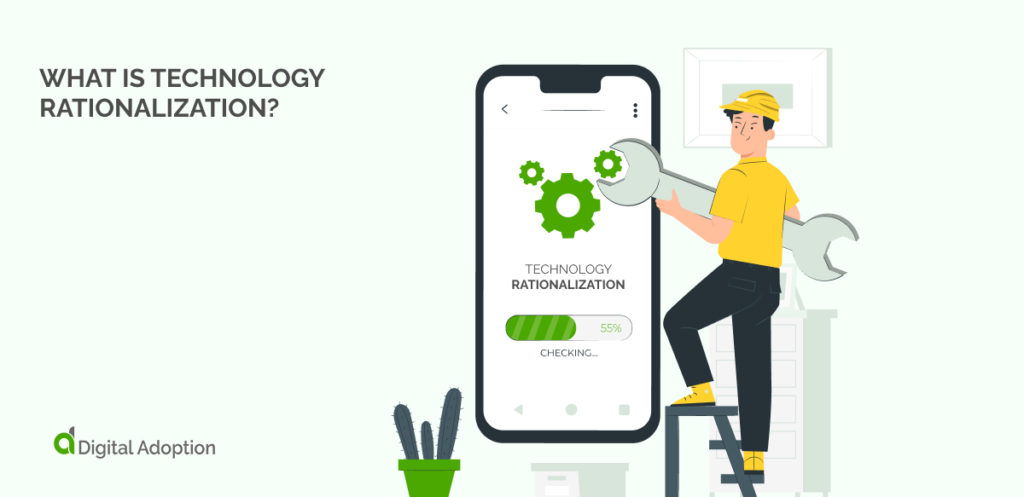
Technology rationalization, shortened to tech-rat, can also be referred to as Application Portfolio Rationalization or IT Portfolio Rationalization and is part of digital transformation strategies. It is the process of minimizing an enterprise’s technology application stack to minimize costs, increase efficiency, optimize business processes, and keep the total cost of ownership (TCO) low as part of a technology-driven organization.
This definition explains technology rationalization projects. But why are they crucial to business processes?
Understanding The Need For Technology Rationalization
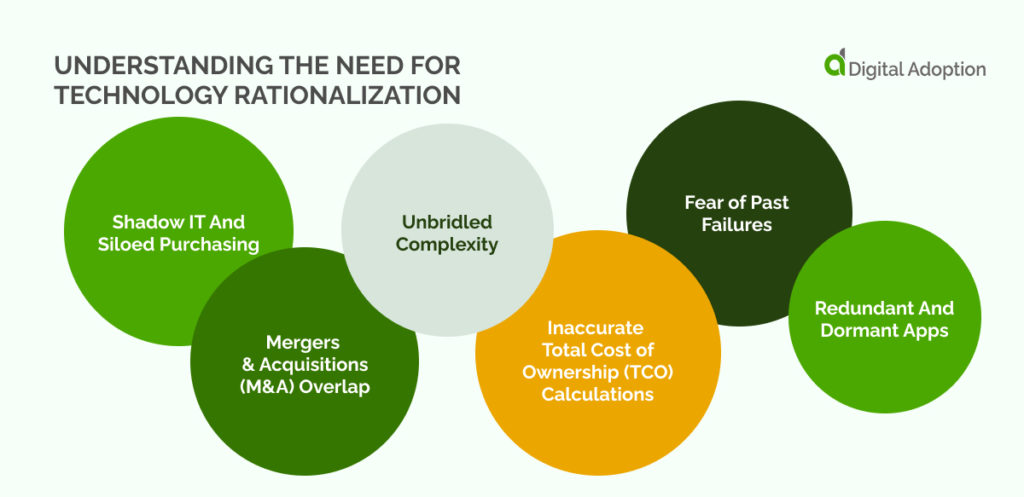
Technology rationalization is analyzing and evaluating your company’s various applications and services to identify the ones that provide the biggest value to your business. This involves assessing each application’s impact on your company’s performance, functionality, and other factors such as ease of use, integration with other systems, cost efficiency, security requirements, and customer satisfaction.
Most companies today use too many applications that reach beyond their needs and do not utilize the savings they could achieve via an application portfolio strategy. Gartner reports that More than 50% of organizations don’t have clear measures of success assigned to their cost management initiatives.
Companies must understand the need for technology rationalization as the first step to building a plan for ensuring they use technology efficiently. The first aspects of this process are shadowed IT and siloed purchases.
Shadow IT And Siloed Purchasing
Shadow IT is any unauthorized use of IT technologies, solutions, services, projects, and infrastructure. When companies take a siloed approach, they ensure that they only give access to staff who need to use specific software for their business operations. This action provides accurate usage figures, informing the best decisions for technology rationalization projects. These steps ensure that the amount of software staff use is always within the necessary levels as the right staff uses the right software.
Mergers & Acquisitions (M&A) Overlap
Organizations can save money by ensuring that technology with the same purpose resulting from M&A from different vendors doesn’t promote overlapping functionality. The way to avoid this is to ensure that when M&As occur, the technology rationalization effort includes a plan to review technology to identify applications with overlapping functionality and remove them to improve efficiency.
Consolidating new tool stacks acquired from M&S to an existing application portfolio can take up to five years or more. It’s essential to plan and be practical when engaging in M&A about application portfolio management as part of a rationalization project.
Unbridled Complexity
Unbridled complexity occurs when too many software solutions have similar or overlapping functions due to poor application portfolio management. This complexity reduces visibility, making it harder to see redundant applications and function overlap. Introducing a more simple perspective increases visibility, improving application portfolio management efficiency.
Fear of Past Failures
Technology rationalization projects are all about learning and evolving based on past mistakes. A culture of accepted mistakes helps to push boundaries and take a more innovative approach to new error practices, being an acknowledged part of a technology rationalization project.
Inaccurate Total Cost of Ownership (TCO) Calculations
Every successful application rationalization initiative depends on calculations to determine TCO, which goes beyond the purchase cost, containing a complex matrix of factors. The most straightforward formula to determine TCO includes three elements:-
- Initial cost (I)
- Maintenance cost (M)
- Remaining costs (R)
TCO = I + M – R
The initial cost considers the initial price you pay for an asset.
The maintenance cost involves the costs to run the technology as a continuous process in the long term.
The remaining cost is what the asset will be worth, for example, five years into the future, helping us make a long-term calculation and better plan for potential devaluation.
When you calculate TCO accurately, you improve efficiency as part of your technology rationalization project.
Redundant And Dormant Apps
Identification and removal of redundant, dormant, or zombie apps are at the core of successful technology rationalization strategies. Companies must perform this task regularly and review it at intervals.
These aspects of a technology rationalization project highlight the need to increase efficiency and optimize the budget. But what obstacles do companies need to be aware of as they begin strategically identifying business applications?
Technology Application Rationalization Obstacles
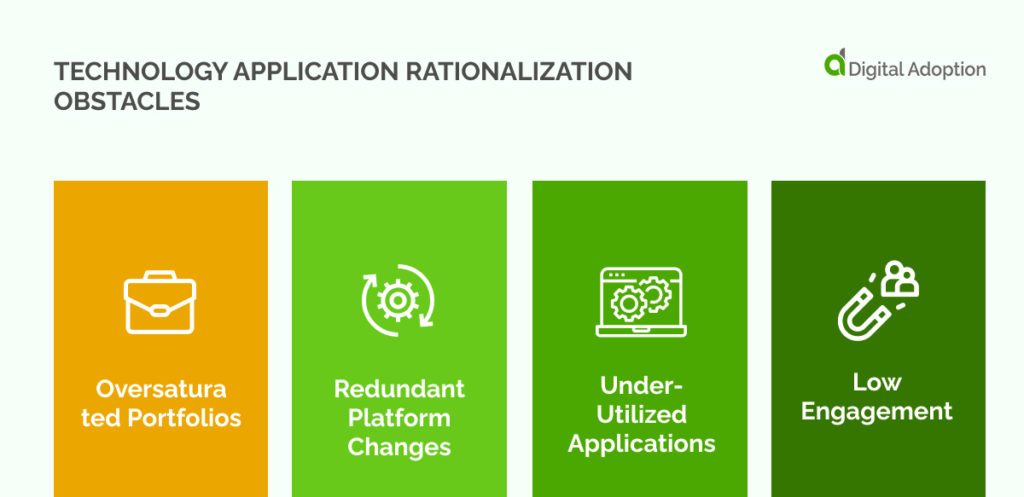
WalkMe indicates in its report, The State of Digital Adoption 2022-2023, that in 2021 companies incurred costs of $100 million due to technological waste. Looking at each obstacle thoroughly provides the best technology application rationalization strategy solutions. The first of these obstacles is oversaturated portfolios.
Oversaturated Portfolios
When an application portfolio is bloated with unnecessary apps, it causes hidden redundancy and locks innovation spending to legacy apps. Therefore, reducing the number of applications is essential to success, as usage and investment outliers are easier to spot in a reduced-size app portfolio. With fewer applications overall, there is also more scrutiny on assessing the business value of new ones.
Redundant Platform Changes
Although it’s a sound IT strategy to increase your SaaS footprint and remove perpetual licenses, transferring all applications from one platform to another without assessing their business value is wasteful. Moving fewer apps involves less technical work overall, allowing time to focus on delivering a portfolio that provides real value to the enterprise.
Under-Utilized Applications
Despite it being easier to buy something new, this approach goes against the purpose of application rationalization initiatives. Organizations that see success with app rate strategies get more out of existing apps before they add anything else to the portfolio.
Low Engagement
If your partners meet initiatives with disinterest, it may be due to a need for more dialogue surrounding the total cost of ownership (TCO) of applications. While this number is difficult to agree upon, it’s vital to have a conversation based on factual information. You will lose accuracy in translation if your assumptions appear too simple or overly complicated. Successful engagement occurs when you find the perfect balance between these two extremes.
It is good to begin where business stakeholders and Infrastructure and Operations (I&O) managers are already aware of issues with certain key areas in their portfolio. An app TCO initiative does not need to be all-encompassing to drive engagement, but you must address areas that staff has already flagged as an issue.
IT managers and CIOs must know these obstacles to ensure they are tackled early for the most successful technology rationalization plans. But what stepped processes exist to guide technology rationalization in a structured way?
The 6-Step Process Application Rationalization Framework
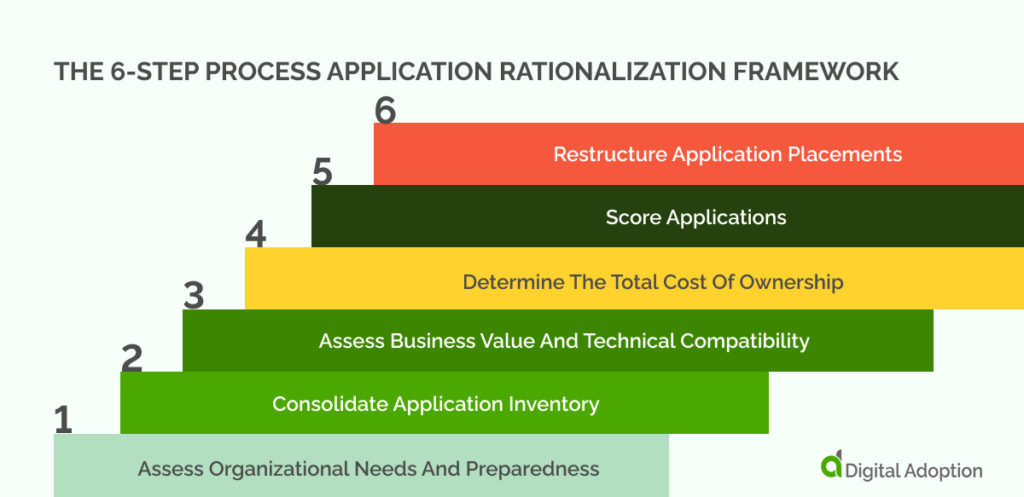
The six-step application rationalization framework combines six steps to allow any IT department to ensure its vision has a solid strategic direction using all the best principles. The first step involves organizational needs and preparedness.
IT Asset Management (ITAM) is a crucial part of the technology rationalization process because it allows users to track their equipment’s usage and performance for decision-making purposes.
Before exploring the process application rationalization framework, it’s worth familiarizing yourself with IT asset management best practices, a set of rules that help to improve the efficiency and performance of an IT Asset Management tool. By following these best practices, teams can meet their goals more effectively and complete tasks faster.
Step 1: Assess Organizational Needs And Preparedness
The first step in the application rationalization framework is a portfolio assessment to identify all the applications needing review, along with their names and application managers. Sometimes an initiative like this will focus on removing retired apps from the portfolio within two quarters. Still, it’s also essential to baseline assess the entire portfolio so you can find any misidentified apps.
To ensure the success of an app rating, business stakeholders must engage early on by helping with portfolio analysis. Doing so gives the context and validation needed to make accurate recommendations. Only two pieces of data are presented to IT finance – an application list and an app-to-server mapping file.
If the source data is incorrect, it renders all rationalization initiatives useless. Therefore, I&O owns and must validate the application list data with operational data for a successful outcome. A portfolio assessment pinpoints which applications running on older systems need unique infrastructure, as maintaining these legacy systems drains development funds that you could use to fuel innovation and growth.
1:1 Launch Preparedness Assessment
Setting business value to applications often leads to organizational pushback. To isolate investments in running the business (RTB) versus growing the business (GTB), analyze application costs according to company functions. Unfortunately, such an analysis can establish a contentious environment where GTB is considered the only actual spend.
Part of IT’s responsibilities is to deliver KTLO (Keep The Lights On) capabilities, but there can be resistance to change if organizations see this as a hindrance to innovation. To avoid this, companies should ensure that their IT budget aligns with their business objectives and get buy-in from various stakeholders during the tech-rat process.
A common side effect of an application rationalization effort is a spike in spending. When companies retrain staff to use a new, rationalized application, there are costs associated with technology adoption and implementation. Companies need to consider sources for retraining in addition to the business value. For example, is it worth using our training resources to cover this? You’ll need to answer these questions to make sure the best deal.
1:2 Determine Scope and Requirements
A portion of the application portfolio has the potential to bring tangible business value. The next logical question then becomes: how well is it performing in bringing this desired business value? Successful tech-rat initiatives work to answer this question.
The effectiveness of an application’s business value is determined by how it can streamline or redefine existing processes. While many applications support already existing methods, the critical question when selecting one for your organization is: how well does this app automate a particular business process? Automation should be the primary functional quality you consider when assessing an application.
With an application rationalization initiative, employees can voice their experience with an application. If an application hampers productivity and harms the user’s attitude, it reflects poorly on the business itself. Department managers must discuss quality limitations to weigh them against IT goals.
IT stakeholders may desire to expand different aspects of cloud footprints, such as IaaS (Infrastructure as a Service) or SaaS. Still, if existing solutions are only available locally or on-premises, that might not be feasible due to a lack of support from outdated infrastructure.
If a SaaS offering is unavailable, only the status quo remains, as you haven’t moved forwards or backward. The more difficult choice occurs when options are in the cloud, and you must weigh every possibility. For example, can you assume that an app will be secure if it’s just in the cloud? If the answer is no, since you’re so invested in modernizing your IT strategy and operating on Cloud, would you heavily invest in making sure it sticks to those parameters?
A change in application portfolios requires a shift in hardware. Offering cloud services allows users to utilize pre-existing on-premises servers and storage for other purposes. However, moving infrastructure to the cloud without taking advantage of the leftover capacity on-premises is wasteful.
1:3 Compose a Questionnaire using metrics
Utilize metrics to show the success of your application rationalization initiative. Eventually, you’ll eliminate applications of low business value and become skilled at not including new low-value apps.
IT teams report the success of initiatives by:
- The number of apps that will be retired because of analysis.
- The number of licenses saved from those retired apps.
- Recovered or avoided server and storage assets from those app retirements (these numbers show our decision’s value).
- The percentage of apps that you reduce over time.
- The percentage of apps with overlapping functionality that you reduce.
- The difference in per-instance costs for prod vs. non-prod instances as a percentage.
- The reduction in TCO (total cost of ownership) over time, expressed as a percentage price Leaner infrastructure, results in a lower TCO.
Application rationalization initiatives examine how we’re already spending on applications and provide ways to use that money more efficiently. Technology should serve the business–not the other way around–so it’s essential to review our application portfolios from a business perspective.
Projects may duplicate functionality or have low quality but are high value, for example. Tech-rat initiatives need monthly financial and operational data to be effective. App TCO (Total Cost of Ownership) analytics should be available for anyone who needs them, not just IT people. And most importantly: these decisions should always come back to what will generate the most value for the business overall.
After assessing overall needs and preparedness, you must consolidate each software solution within your application portfolio.
Step 2: Consolidate Application Inventory
The next step of the six-step plan is to take inventory to ensure effective app portfolio management. This action involves recording every app in the portfolio to provide all necessary apps remaining, and you remove all unused apps. The first process for this step is to launch a questionnaire to collect data.
2:1 Launch Questionnaire
The first step is to launch a questionnaire in a way your company will feel is appealing and will be able to engage. Doing so will allow you to collect the best quality feedback that you can use in later stages. Pulse surveys, detailed surveys at less frequent intervals, and points of contact to receive feedback for each department at effective means of collecting feedback.
2:2 Validate Feedback
When you have collected feedback, record the data and update staff to assure them that you will act on their feedback. Tech validation is a continuous process, and staff should feel included in receiving information relevant to their department and role and decision-making where possible.
2:3 Streamline Application portfolio Procurement
Streamlining your supplier portfolio saves you time and money by requiring fewer orders.
The process begins with analyzing which suppliers you can replace and making a list of the products they supply. By identifying a replacement for just one product, you can easily list all other products offered by that specific distributor.
You can then publish this information into an e-procurement solution, where anyone in your company can order the products with little to no hassle. Taking these extra minutes out of your day is significant cost savings and a simplified ordering process.
Step 3: Assess Business Value And Technical Compatibility
Assessing the business value, technical quality, and compatibility is critical in completing your tech rationalization project. The first process within this is to compile technical value and compatibility research.
3:1 Compile Technical Value and Compatibility Research
When analyzing successful apps, it is essential to distinguish between the app’s name and its business value. For example, Trello is a SaaS-based project management software. When defining an app rat initiative, it must be easy to assess the application’s business value.
This action makes it easier to identify capabilities in similar applications that are no longer needed (“We have Trello, but we also have surpluses licenses for Wrike and Nutcache. Let’s agree on one standard and retire the others.”).
3:2 Determine Application Dependencies
Suppose an organization’s app servers are all in one rationalized location, which negatively affects productivity because it limits I&O availability to only one region’s core business hours. In that case, there may be a business need for redundant capabilities.
Step 4: Determine The Total Cost Of Ownership
It’s crucial to determine the cost of ownership (TCO) as part of the six-step process. Begin by assessing the current state of your TCO process.
4:1 Assess the Current State of the TCO Process
The total cost of ownership (TCO) for an application must consider everything that goes into supporting and delivering it, including the accounting entries for both license costs and indirect infrastructure and operational expenses. To acquire this figure, you need to review the cost outliers. The big question with TCO analysis is always accuracy: How accurate are these numbers?
4:2 Review Cost Outliers
To ensure the success of your app rat initiative, you’ll need to analyze TCO regularly. With cost transparency apps, you can upload monthly operational and financial data for IT finance to study and draw self-serve analytics.
When conducting an application TCO analysis, it’s vital that you keep costs in mind, as well as what drives those costs—this way, you can be allocated project spending accordingly for each application.
Step 5: Score Applications
Pinpoint a fraction of the application portfolio as enhanced business value. The next question then becomes: how efficiently are we delivering this business value? Practical tech-rat projects attend to this question.
5:1 Build a Reliable Scoring Framework
To assess an application’s business value, look at how well it supports existing processes and functionality. An organization might select an application that props up an existing process or uses the app to redefine the process (e.g., sales stages with Salesforce SalesCloud). But what matters is how much automation the application offers.
5:2 Review Scores
Any IT goals that stakeholders want to achieve must scrutinize limitations. There might be a desire to branch out to the cloud more for IaaS and SaaS solutions. Still, if existing solutions can only happen on-prem with older infrastructure support, that’s all possible.
If you can’t find a SaaS offering, you’re left where you started. But if there are options in the cloud, it’s even tougher to decide what to do next. How can you be sure that an app will be secure in the cloud? And if you’re wedded to your IT strategy on the cloud, how much should you invest in modernization?
5:3 Engage Application Owners For Feedback
Employees are more likely to be engaged with the business if they have a say in the company’s applications. By allowing employees to weigh in on their experience with an application, companies can get insights into whether an application is user-friendly and efficient.
Step 6: Restructure Application Placements
The assessment of an app portfolio typically starts with names and owners. However, a more holistic approach that assesses the entire portfolio may uncover issues (like incorrect labeling of retired vs. active apps) that are important to the current initiative. This action also establishes the necessary groundwork for follow-on broader tech-rat initiatives.
Business stakeholders should get involved in app rat initiatives as soon as possible by helping with the portfolio analysis. The only resources an IT Finance department has is an application list and an app-to-server mapping file. This data needs to be put into context and validated.
Recommendations from an application rationalization initiative will be meaningful only if the source data is correct. A successful application rationalization initiative depends on accurate, validated data. Finance doesn’t own this information—I&O does, and we must validate application list data using operational data.”
An application portfolio assessment shows which older systems need unique infrastructure, so you can prioritize development spending to areas that create new value.
6:1 Allocate Applications Based on Application Feedback Metrics
This section of the process’s final step depends on the quality of the collected feedback. Ensure that IT works with each department to set up the staff with training and support to use each application.
6:2 Assess Prospective TCO and Vendor Hosting Options
Assessing the prospective TCO and vendor hosting options allows budgets to be accurate. It is essential to establish vendor issues such as frequency of payment and whether it involves monthly hosting fees only or annual license fees.
If needed, you must also factor in security, training, and support fees to establish the accurate TCO for an application portfolio.
6:3 Build A Migration and Change Management Strategy
Moving to a new application portfolio management strategy is stressful for staff. A migration and change management strategy ensures that staff feel supported and can give feedback to managers if they struggle to adjust to a new portfolio rationalization process.
10 Crucial Technology Rationalization App Features
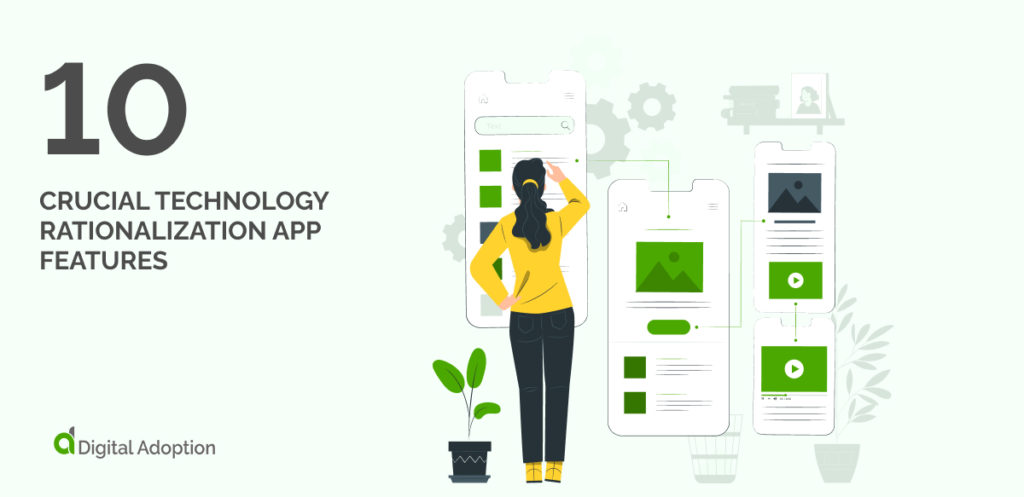
Getting the essential features for your technology rationalization application is crucial.
Here are the best features you need to seek out:
- Billing automation
- Content management
- HR management tools
- Business intelligence (BI)
- Enterprise searching capability
- Customer and call center support
- Email communication for Customer relationship management (CRM)
- Enterprise resource planning (ERP) features
- Project management tools
- Compensation processing
It is essential to ensure your tech rationalization project includes the best software features to get the most out of all your software solutions. But what are the best technology rationalization project apps for 2022?
Top 5 Enterprise Technology Rationalization Apps for 2022
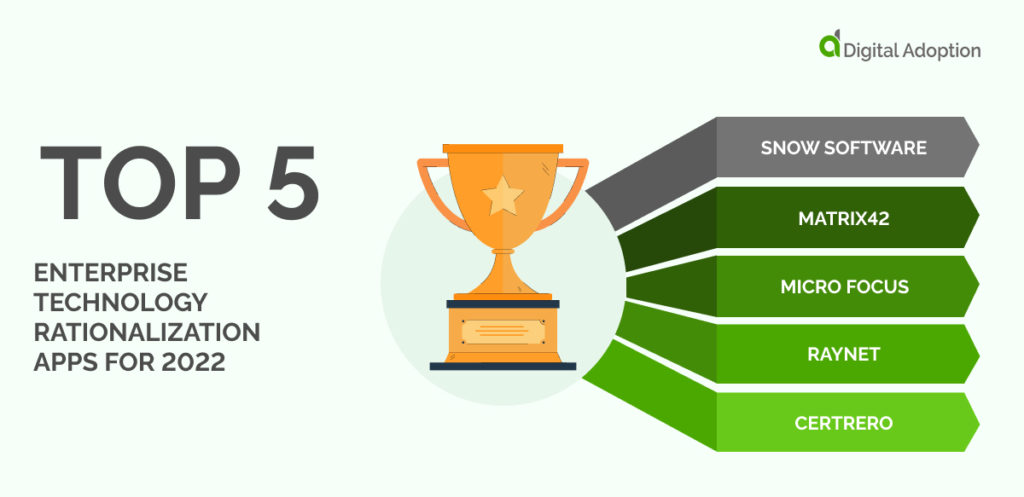
The best enterprise architecture helps you to choose the best technology solutions. Our top five tech rationalization applications show you the best tools to select the best technology. All of these solutions are rated 4.5/5 or higher by Gartner Peer Insights.
1. Snow Software
The Snow Software tech rationalization tool offers a broad view of all on-premises, mobile, data center, and cloud assets under your purview. Use Snow Adoption Tracker to see everything in one place for a quick snapshot of what hardware and software are installed, making it easy to manage cost implications and software compliance risks.
2. Matrix42
Matrix42 has various modules depending on your needs, and much customization is available. Use it to integrate and consolidate data from SCCM and SQL and import data from custom-made asset managers. You can also create new connectors with different solutions.
3. Micro Focus
Micro Focus provides stable and reliable license management software that is also very user-friendly. Micro Focus’s SAM Spider software allows organizations to use only one tool for all license management tasks instead of switching between multiple solutions. The tool sends reminders about the expiration and cancellations of contracts via email, which can be beneficial to help firms reduce their IT spending. Thanks to its ability to store asset, license, and contract data all in one place, it has been an excellent solution for many companies as part of their IT rationalization project.
4. Raynet
RayVentory is a tech rationalization tool many companies use for geographically remote and local devices. With its agentless technology, IT can scan hardware and software devices remotely or through agents at a low cost while maintaining comprehensive reports. Additionally, this allows for detecting unmanaged or disconnected devices as the process removes the need for complex IT infrastructures or data centers.
5. Certrero
Certero Enterprise Premium Edition is the solution to all of your old challenges. With this simple and easy-to-use SaaS solution, any size enterprise can gain clarity and control over IT hardware, software, and business intelligence in no time at all.
Certero’s inventory enables you to make sound decisions with the confidence that comes from knowing all your assets and having access to information about them. Certero provides a modern Single Platform Solution that is convenient and intuitive while delivering measurable business benefits. Features include:-
- IT hardware and software asset management,
- software distribution,
- device and user access control, and
- Automated software recognition.
These examples give some idea of what is available on the market. Always ask vendors if there is a trial version that your team can use for a month to ensure it fits your needs.
What Is Tool Fragmentation?
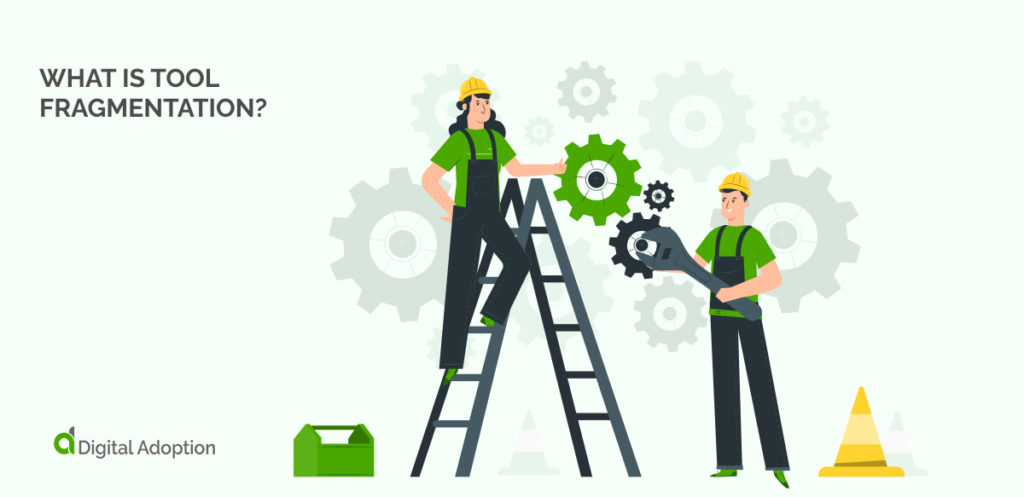
While you can fix some IT problems, you can only manage others. Tool fragmentation is one of those latter challenges enterprises typically have to learn to deal with — it’s not a problem with a clear solution.
Companies use tech rationalization to combat tool fragmentation. This process is crucial, but even after implementing tech rationalization, most businesses end up fragmented.
For example, many large companies try to streamline their cross-functional team working processes using Microsoft products like email, chat, office applications, and file storage. Nearly every enterprise uses multiple software programs for collaboration, even if they have chosen Microsoft as their primary vendor. This scenario indicates that simply making a directional choice to standardize with one vendor doesn’t guarantee it will happen.
In the IT Ops world, organizations have traditionally aligned themselves with one vendor, such as HP or IBM. However, it is increasingly rare to find a company that uses just one of these vendors for its entire IT operations stack.
Fragmentation vs. Rationalization
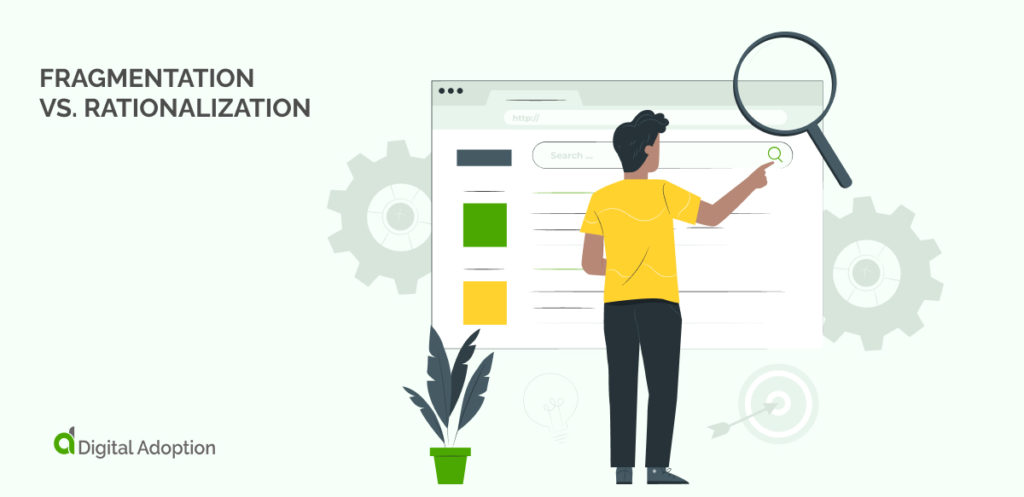
With this description of the need to consider fragmentation, the question is, how is fragmentation different from tech rationalization? Fragmentation is the process by which a company’s use of software becomes separated, messy, and no longer joined up and organized. The tech rationalization process aims to bring together and simplify the use of technology by removing redundant applications through well-recorded and regularly reviewed application portfolio management. In this way, fragmentation and rationalization link together.
Streamline Business Processes With Tech Rationalization
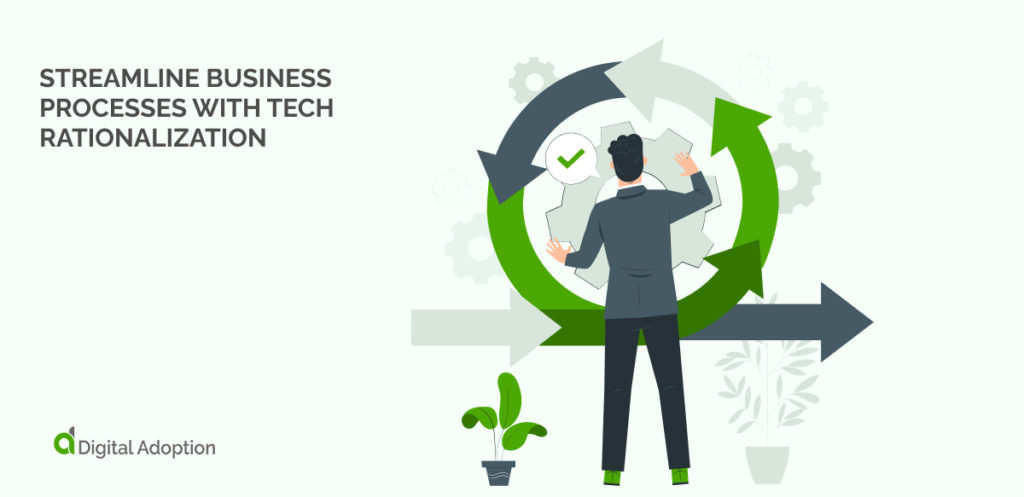
Implementing tech rationalization can be daunting, but the potential cost savings are too significant to ignore. Industry leaders have acknowledged the importance of successful application rationalization initiatives in achieving better business outcomes. And taking steps towards rationalizing your company’s technology usage can improve outcomes for IT stakeholders.
If you’re ready to begin saving money for your business, now is the time to start your tech rationalization plan as part of your digital transformation.













